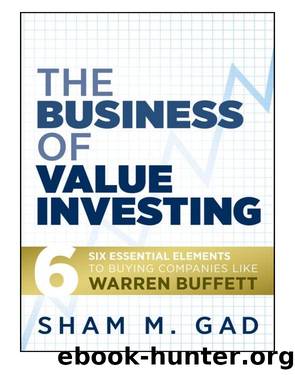The Business of Value Investing by Sham M. Gad

Author:Sham M. Gad
Language: eng
Format: epub
Publisher: Wiley
Published: 2010-05-11T00:00:00+00:00
The greatest error to which investors fall prey is relating the price level of a security with the anticipated future value to be received. The common mode of thought is this: A security trading at $2 a share can easily get to $4 whereas a company like ConocoPhillips will have a far harder time getting to $104 from $52. In one sense, this may indeed be very true. It will require far more capital and investor interest to add the $70 billion in market value that would be needed to double the share price of ConocoPhillips; far less capital would be needed to move shares from $2 to $4. The danger in thinking this way is that the approach is no longer of that of investing but of speculation.
We have all heard investors who rationalize that when a stock price gets so low, it surely cannot go any lower. Thinking about a stock in this manner is misguided and usually leads to financial pain. Stock prices should always be thought about in relation to intrinsic value and degree of discount offered from intrinsic value. After all, until a stock price has reached zero, it always can go lower. It is crucial to realize the element of uncertainty in investing. The market hates uncertainty; in most cases, the low price due to uncertainty is justified. In some cases, though, the uncertainty leads to a price level that offers tremendous value. The goal of the intelligent investor is to exert diligent effort in understanding and valuing the specific situation. If that is not possible, the investor should abandon the security until he or she has a better view of things.
The notion of price to value with respect to discipline cannot be overemphasized, especially when we are talking about money and Wall Street. Wall Street has turned the investment profession into one dominated by egos motivated by who can accumulate the most in the shortest amount of time regardless of the soundness of the approach. If you are not participating in the moneymaking operation of the time, youâve lost your touch. The mortgage and credit fiasco that imploded in the fall of 2008 with the fall of Bear Stearns and the bankruptcy of Lehman Brothers illustrates exactly what can happen when a disciplined approach takes a backseat to emotion and envy.
Eager to exploit the abundance of credit and rising property values, financial institutions raced each other to extend the most credit. Whether it was a storied Wall Street institution or a newly opened mom and pop with a shingle reading âMortgages Available Here,â the money to be made by lending, selling the loans, and lending some more was too easy to pass up. There was no need to hold back and be disciplined; houses were the safest asset next to Treasuries, the financial pros told us, because house prices would always go up over time and there would always be buyers. Hundreds of billions of dollars were invested based on complex models that all relied on one simple assumption: The price of a house could never decline.
Download
This site does not store any files on its server. We only index and link to content provided by other sites. Please contact the content providers to delete copyright contents if any and email us, we'll remove relevant links or contents immediately.
Rich Dad Poor Dad by Robert T. Kiyosaki(6413)
Pioneering Portfolio Management by David F. Swensen(6229)
How To Win Friends and Influence People by Dale Carnegie(4447)
The Money Culture by Michael Lewis(4082)
The Dhandho Investor by Mohnish Pabrai(3705)
The Wisdom of Finance by Mihir Desai(3658)
Liar's Poker by Michael Lewis(3372)
Fooled by Randomness: The Hidden Role of Chance in Life and in the Markets by Nassim Nicholas Taleb(3048)
The ONE Thing by Gary Keller(3010)
The Intelligent Investor by Benjamin Graham Jason Zweig(2995)
Mastering Bitcoin: Programming the Open Blockchain by Andreas M. Antonopoulos(2982)
Rich Dad Poor Dad: What The Rich Teach Their Kids About Money - That The Poor And Middle Class Do Not! by Robert T. Kiyosaki(2909)
How to Day Trade for a Living: Tools, Tactics, Money Management, Discipline and Trading Psychology by Andrew Aziz(2909)
Investing For Dummies by Eric Tyson(2894)
How to Win Friends and Influence People by Dale Carnegie(2863)
Market Wizards by Jack D. Schwager(2645)
The Psychology of Money by Morgan Housel(2623)
Zero Hour by Harry S. Dent Jr. & Andrew Pancholi(2614)
How to Pay Zero Taxes, 2018 by Jeff A. Schnepper(2602)
